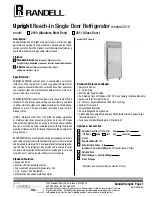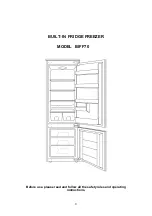
3-4. Practical Work For Heavy Repair
TROUBLE DIAGNOSIS
- 64 -
Items
Precautions
1. Removal of residual
refrigerant.
1) Remove residual refrigerant more than 5 minutes later after turning off the refrigerator.
( If not, compressor oil may leak inside.)
2) Remove retained refrigerant slowly by cutting first high pressure side (drier part) with a
nipper and then cut low pressure side.
2. Nitrogen blowing
welding.
When replacing a drier:
Weld
and
parts by blowing nitrogen(0.1~0.2kg/cm
2
) to high pressure side after
assembling a drier.
When replacing a compressor:
Weld
and
parts by blowing nitrogen to the low pressure side.
Note) For other parts, nitrogen blowing is not necessary because it does not produce oxidized
scales inside pipe because of its short welding time.
3. Replacement of drier.
Inserting a capillary tube
Measure distance with a ruler and put a mark(12
+3/-0
)on the capillary tube. Insert tube to the
mark, and weld it
KEYPOINTING
Observe the sequence for
removal of refrigerant.
(If not, compressor oil may
leak.)
KEYPOINTING
Welding without nitrogen
blowing produces oxidized
scales inside a pipe, which
affect on performance and
reliability of a product.
KEYPOINTING
Be sure to check the
inserted length of capillary
tube when it is inserted. (If
too much inserted, a
capillary tube is clogged by
a filter.)
Compressor
Low pressure side
Condenser
High pressure side
Drier
Evaporator
Release
Refrigent
Intake
Suction
1
2
1
2
Evaporator
Drier
High pressure side
Condenser
Refrigent
Intake
12
+
3
-
0
Filter
* Unit : mm
Summary of Contents for GC-A207
Page 28: ...3 2 Parts list 1 GR A207 EXPLATION FOR MICOM CIRCUIT 28 ...
Page 29: ...3 3 DISPLAY ASSY part diagram 1 GR A207 EXPLATION FOR MICOM CIRCUIT 29 ...
Page 30: ...3 4 DISPLAY circuit diagram 1 GR A207 EXPLATION FOR MICOM CIRCUIT 30 ...
Page 32: ...EXPLATION FOR MICOM CIRCUIT 32 ...
Page 33: ...CIRCUIT 33 ...
















































